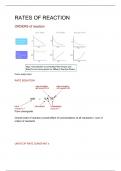-
1. Flashcards - Orders of reaction & half-life
-
2. Flashcards - Electron structure a level chemistry
-
3. Flashcards - Formulaes of complex ions and definitions of atomic mass
-
4. Flashcards - Ionic and covalent + coordinate bonds
-
5. Flashcards - Shapes of covalent bonds and electronegativity
-
6. Flashcards - Bonding and structure, intermolecular forces
-
7. Flashcards - Periodicity, group 2-7 and tests for ions module 3
-
8. Summary - Animal responses summary
-
9. Summary - Excretion topic summary
-
10. Summary - Cell membranes summary
-
11. Summary - Neuronal communication summary
-
12. Summary - Electronic structure & bonding and structure summary
-
13. Summary - Module 3 periodicity, group 2 and halogens summary
-
14. Summary - Module 5 rates of reaction and equilibria summary
-
15. Summary - Enthalpy module 3 summary
-
16. Summary - Hormonal communication summary
-
17. Summary - Module 2 cells & biological molecules summary (cgp)
-
18. Summary - Photosynthesis summary
-
19. Summary - Plant responses and hormones summary
-
20. Summary - Respiration topic summary with diagrams
-
21. Summary - Thermoregulation topic summary
-
22. Summary - Eletrochemical cells summary
-
23. Summary - Ecosystems a level biology notes
-
24. Summary - A level biology biodiversity module 4 summary
-
25. Summary - Biology patterns of inheritance summary
-
26. Summary - A level biology animal responses summary
-
27. Summary - A level biology enzymes summary module 2
-
28. Summary - Gas exchanges module 3 biology notes
-
29. Summary - Nucleic acids biology summary
-
30. Summary - Ocr a level biology proteins summary module 2
-
31. Summary - A level biology animal transport summary
-
32. Summary - a level biology plant transport summary
-
33. Summary - A level biology evolution summary module 4
-
34. Summary - A level biology communicable diseases summary
-
35. Summary - A level biology cellular control summary module 6
-
36. Summary - A level biology biotechnology and cloning summary
-
37. Summary - Populations and sustainability biology kerboodle notes
-
38. Summary - Manipulating genomes summary biology
-
39. Summary - Rates of reactions and equilibria chemistry notes
-
40. Summary - Acids, bases,ph, titration curves chemistry notes
-
41. Summary - Lattice enthalpy and entropy, born haber cycles chemistry notes
-
42. Summary - Transition elements and redox chemistry notes
-
43. Summary - Ocr a level chemistry module 4 summary
-
44. Summary - Organic chemistry module 6 full summary
-
45. Summary - Organic chemistry chromatography notes module 6
-
Show more




